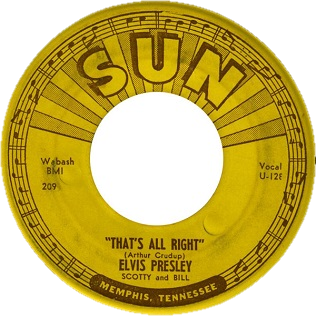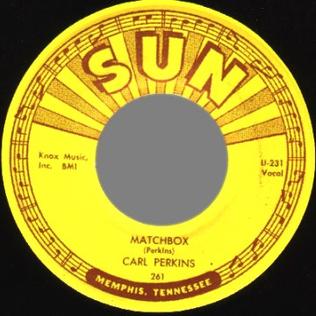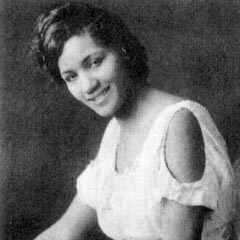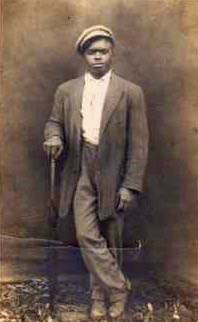
Lemon Henry "Blind Lemon" Jefferson was an American blues and gospel singer-songwriter and musician. He was one of the most popular blues singers of the 1920s and has been called the "Father of the Texas Blues".

Paramount Records was an American record label known for its recordings of jazz and blues in the 1920s and early 1930s, including such artists as Ma Rainey, Tommy Johnson and Blind Lemon Jefferson.

Blind Willie Johnson was an American gospel blues singer, guitarist and evangelist. His landmark recordings completed between 1927 and 1930—thirty songs in total—display a combination of powerful "chest voice" singing, slide guitar skills, and originality that has influenced generations of musicians. Even though Johnson's records sold well, as a street performer and preacher, he had little wealth in his lifetime. His life was poorly documented, but over time, music historians such as Samuel Charters have uncovered more about Johnson and his five recording sessions.

"That's All Right" is a song written and originally performed by the American blues singer Arthur Crudup and recorded in 1946. It was rereleased in early March 1949 by RCA Victor under the title "That's All Right, Mama", which was issued as RCA's first rhythm and blues record on its new 45 rpm single format.

"Matchbox" is a song written and recorded by Carl Perkins and released in 1957. Blind Lemon Jefferson wrote and recorded a song entitled "Match Box Blues" in 1927, which is musically different but which contains some lyric phrases in common.
Victoria Regina Spivey, sometimes known as Queen Victoria, was an American blues singer, songwriter, and record company founder. During a recording career that spanned 40 years, from 1926 to the mid-1960s, she worked with Louis Armstrong, King Oliver, Clarence Williams, Luis Russell, Lonnie Johnson, and Bob Dylan. She also performed in vaudeville and clubs, sometimes with her sister Addie "Sweet Peas" Spivey, also known as the Za Zu Girl. Among her compositions are "Black Snake Blues" (1926), "Dope Head Blues" (1927), and "Organ Grinder Blues" (1928). In 1961, she co-founded Spivey Records with one of her husbands, Len Kunstadt.
Classic female blues was an early form of blues music, popular in the 1920s. An amalgam of traditional folk blues and urban theater music, the style is also known as vaudeville blues. Classic blues were performed by female singers accompanied by pianists or small jazz ensembles and were the first blues to be recorded. Ma Rainey, Bessie Smith, Ethel Waters, and the other singers in this genre were instrumental in spreading the popularity of the blues.

Hudson Whittaker, known as Tampa Red, was an American Chicago blues musician.
"Corrine, Corrina" is a 12-bar country blues song in the AAB form. "Corrine, Corrina" was first recorded by Bo Carter. However, it was not copyrighted until 1932 by Bo Carter, along with his publishers Mitchell Parish and J. Mayo Williams.
Black Snake Moan may refer to:
"See See Rider", also known as "C.C. Rider", "See See Rider Blues" or "Easy Rider", is a popular American 12-bar blues song that became a standard in several genres. Gertrude "Ma" Rainey was the first to record it on October 16, 1924, at Paramount Records in New York. The song uses mostly traditional blues lyrics to tell the story of an unfaithful lover, commonly called an "easy rider": "See see rider, see what you have done", making a play on the word "see" and the sound of "easy".
"Walkin' Blues" or "Walking Blues" is a blues standard written and recorded by American Delta blues musician Son House in 1930. Although unissued at the time, it was part of House's repertoire and other musicians, including Robert Johnson and Muddy Waters, adapted the song and recorded their own versions.
"Crawling King Snake" is a blues song that has been recorded by numerous blues and other artists. It is believed to have originated as a Delta blues in the 1920s and be related to earlier songs, such as "Black Snake Blues" by Victoria Spivey and "Black Snake Moan" by Blind Lemon Jefferson.
Willard "Ramblin'" Thomas was an American country blues singer, guitarist and songwriter. He is best remembered for his slide guitar playing and for several recordings he made in the late 1920s and early 1930s. Blues scholars seem undecided if his nickname referred to his style of playing or to his itinerant nature. He was the brother of the blues musician Jesse Thomas.

Virginia Liston was an American classic female blues and jazz singer. She spent most of her career in vaudeville. She performed with her husband, Samuel H. Gray, as Liston and Liston. In the 1920s she made a series of recordings that included performances with Clarence Williams and his Blue Five on "You've Got the Right Key, but the Wrong Keyhole" and "Early in the Morning", and with the Clarence Williams Washboard Band on "Cushion Foot Stomp", and "P.D.Q. Blues".
The "Deep Elm Blues" is an American traditional song. The title of the tune refers to the historical African-American neighborhood in downtown Dallas, Texas known as Deep Ellum, which was home to music legends Blind Lemon Jefferson, Blind Willie Johnson, Lead Belly, and Bill Neely.

The Country Blues is a seminal album released on Folkways Records in 1959, catalogue RF 1. Compiled by Samuel Charters from 78-rpm recordings, it accompanied his book of the same name to provide examples of the music discussed. Both the book and the album were key documents in the American folk music revival of the 1950s and 1960s, and many of its songs would either be incorporated into new compositions by later musicians, or covered outright.
Freddie Spruell was an American Delta blues guitarist and singer, variously billed as Papa Freddie or Mr. Freddie. He is generally regarded as the first Delta bluesman to be recorded, although Mamie Smith (1920), Ed Andrews (1923) and Blind Lemon Jefferson (1925) predated him in recording the first blues records. Details of his life are sketchy and sometimes contradictory.

Bernice Edwards was an American classic female blues singer, pianist and songwriter. She recorded a total of 21 tracks between 1926 and 1935. Unusually for a female blues performer at the time, Edwards composed some of her songs. Details of her life outside the recording studio are sketchy.
Willie Baker was an American Piedmont blues guitarist, singer and songwriter. He recorded eight tracks, playing a twelve-string guitar to back his own strong vocals. All of his recordings took place in January and March 1929 in Richmond, Indiana, United States. Details of his life outside of his recording career are sketchy.









